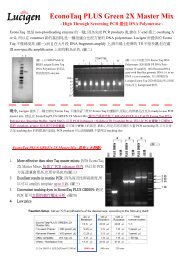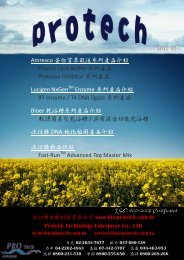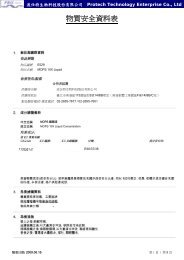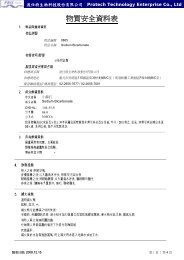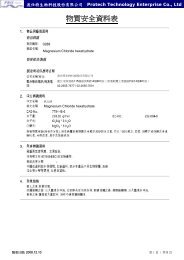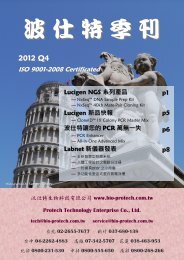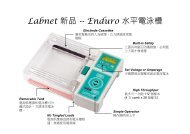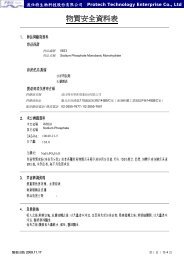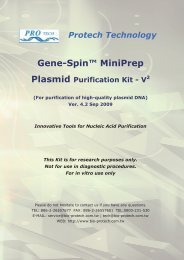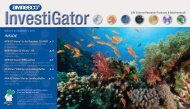g AxyPrep DNA Gel Extraction Kit
g AxyPrep DNA Gel Extraction Kit
g AxyPrep DNA Gel Extraction Kit
You also want an ePaper? Increase the reach of your titles
YUMPU automatically turns print PDFs into web optimized ePapers that Google loves.
08/05 Ver. 12. Add a 3x sample volume of Buffer DE-A.Note: The color of Buffer DE-A is red. This color is used to add contrast in the next step, so that any pieces ofunsolubilized agarose can be visualized.3. Resuspend the gel in Buffer DE-A by vortexing. Heat at 75°C until the gel is completely dissolved(typically, 6-8 minutes). Heat at 40°C if low-melt agarose gel is used. Intermittently vortexing (every2-3 minutes) will accelerate gel solubilization.IMPORTANT: <strong>Gel</strong> must be completely dissolved or the <strong>DNA</strong> fragment recovery will be reduced.IMPORTANT: Do not heat the gel for longer than 10 minutes.4. Add 0.5x Buffer DE-A volume of Buffer DE-B, mix. If the <strong>DNA</strong> fragment is less than 400 bp,supplement further with a 1x sample volume of isopropanol.Example: For a 1% gel slice equivalent to 100 μl, add the following:• 300 μl Buffer DE-A• 150 μl Buffer DE-BIf the <strong>DNA</strong> fragment is
08/05 Ver. 1<strong>DNA</strong> <strong>Gel</strong> <strong>Extraction</strong> Spin Protocol1. Excise the agarose gel slice containing the <strong>DNA</strong> fragment of interest with a clean, sharp scalpelunder ultraviolet illumination. Briefly place the excised gel slice on absorbent toweling to removeresidual buffer. Transfer the gel slice to a piece or plastic wrap or a weighing boat. Mince the gelinto small pieces and weigh. In this application, the weight of gel is regarded as equivalent to thevolume. For example, 100 mg of gel is equivalent to a 100 μl volume. Transfer the gel slice into a1.5 ml microfuge tube.Note: Alternatively, the gel slice can be placed into the 1.5 ml microfuge tube and then crushed with a pipette tip orother suitable device. Spin the tube for 30 sec at 12,000xg to consolidate the gel at the bottom of the tube.Use the graduations to estimate the volume of the agarose gel.2. Add a 3x sample volume of Buffer DE-A.Note: The color of Buffer DE-A is red. This color is used to add contrast in the next step, so that any pieces ofunsolubilized agarose can be visualized.3. Resuspend the gel in Buffer DE-A by vortexing. Heat at 75°C until the gel is completely dissolved(typically, 6-8 minutes). Heat at 40°C if low-melt agarose gel is used. Intermittent vortexing (every2-3 minutes) will accelerate gel solubilization.IMPORTANT: <strong>Gel</strong> must be completely dissolved or the <strong>DNA</strong> fragment recovery will be reduced.IMPORTANT: Do not heat the gel for longer than 10 minutes.4. Add 0.5x Buffer DE-A volume of Buffer DE-B, mix. If the <strong>DNA</strong> fragment is less than 400 bp,supplement further with a 1x sample volume of isopropanol.Example: For a 1% gel slice equivalent to 100 μl, add the following:• 300 μl Buffer DE-A• 150 μl Buffer DE-BIf the <strong>DNA</strong> fragment is
08/05 Ver. 19. Discard the filtrate from the 2 ml microfuge tube. Place the Miniprep column back into the 2 mlmicrofuge tube. Centrifuge at 12,000xg for 1 minute.10. Transfer the Miniprep column into a clean 1.5 ml microfuge tube (provided). To elute the <strong>DNA</strong>,add 25-30 μl of Eluent or deionized water to the center of the membrane. Let it stand for 1 minuteat room temperature. Centrifuge at 12,000xg for 1 minute.Note: Pre-warming the Eluent at 65°C will generally improve elution efficiency.Note: Deionized water can also be used to elute the <strong>DNA</strong> fragments.OverviewExcise gel<strong>Gel</strong> containing <strong>DNA</strong>Add Buffer DE-A, heat at 75°C to melt gelSolubilizationAdd 0.5× Buffer DE-A volume of Buffer DE-BAdd 500 μl of Buffer W1Add 700 μl of Buffer W2Repeat wash with Buffer W2BindingWashingElute with 25-30 μl of Eluent or deionized waterElutionTroubleshooting1. Low or no recovery<strong>Gel</strong> not completely solubilizedIncomplete solubilization of the agarose gel will allow the <strong>DNA</strong> fragments to be masked from the<strong>AxyPrep</strong> membrane surface, preventing interaction and binding. Depending upon the amount ofincompletely solubilized gel remaining in the sample, only partial binding of the fragments mayoccur, resulting in premature elution and fragments loss during the ensuing wash steps. Usually,this is attributable to processing too much agarose (too large and/or too high percentage). Be sureto use the correct amount of Buffer DE-A. Carefully inspect the sample during heating to be surethat no solid agarose remains. Use frequent vortexing during heating to enhance solubilization.Axygen Biosciences 33210 Central Avenue, Union City, CA 94587 USA Tel:510-494-8900 Fax:510-494-0700 e-mail:support.axyprepkits@axygenbio.com web:www.axygenbio.compage 5
08/05 Ver. 1Poor fragment bindingTo ensure complete solubilization of the agarose, increase the amount of Buffer DE-A to 4× thesample volume. Trim the gel as close to the <strong>DNA</strong> fragments as possible to minimize the amount ofagarose processed. Be sure to supplement the solubilized agarose containing <strong>DNA</strong> fragments



